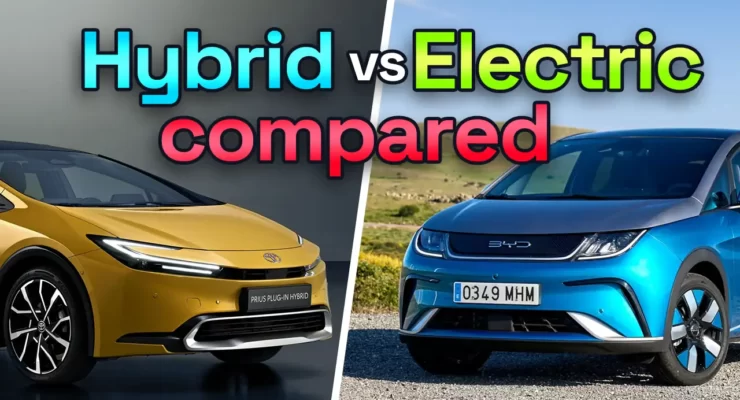Fast read
To be powered by both electricity and petrol, hybrid vehicles combine an electric battery and electric motor with the power of an internal combustion engine.
Currently, there are two different hybrid car kinds available. The first of these is a conventional hybrid car that uses a traditional combustion engine to power the battery, which is then employed as a backup power source.
The second type of hybrid car is a plug-in hybrid. These vehicles feature a larger battery so that the electricity can be used as a stand-alone power source and can be charged through a charging station.
The primary distinction between fully electric cars and hybrid cars is that fully electric cars don't need any fuel, whereas hybrid cars do, but of course, their petrol consumption for 100km is much less than a conventional combustion engine vehicle eg 4.8l per 100 km vs 10l per 100 km.
It is difficult to work out if hybrid vehicles or EVs are cheaper to run in the long run, as, the battery replacement in a full EV will need to be taken into account as well when working out this comparison. In any case, both models will add significant savings compared to a petrol car.
Is a Hybrid vs Electric Car cheaper to run?
Like electric vehicles, hybrid vehicles are an alternative to traditional gas-powered vehicles, which can reduce emissions and, in many cases, costs. The difference between the two vehicles is that one needs to be recharged only, and the other needs to be refuelled. Nevertheless, there are numerous other disparities between hybrid vs electric vehicles that are not so widely known.
What is a hybrid vehicle?
As the name suggests, a hybrid vehicle is a combination of both electric vehicles and internal combustion vehicles. This means hybrid vehicles have a combustion engine and an electric motor with a rechargeable battery pack. Hybrid vehicles can also use both engines simultaneously for increased power or utilise only one, depending on the driving situation. Two types of hybrid vehicles exist;
- Standard hybrids
- Plug-in hybrids (PHEV)
The standard hybrid uses regenerative braking and an internal combustion engine which charges the battery pack, providing extra electric power.
On the flip side, plug-in hybrids can be charged at charging stations and typically feature a larger battery pack than a standard hybrid car. This larger battery size gives them the capability to operate solely on electricity from the battery.
Hybrid vehicles generally have a smaller battery than pure electric vehicles. In general, their design aims to maximise fuel and energy efficiency by utilising the electric motor for lower speeds, while the dual motors or petrol engine come into play for faster travel.
Plug-in hybrids are seen as an intermediate option for changing from fuel to electric vehicles and renewable energy.

What’s the cost difference between Hybrid vs Electric Vehicles
Initial costs – Hybrid vs Electric Vehicles
The first consideration you will come across is the initial purchase price. In Australia, the average cost of a new hybrid vehicle in 2022 was $39,000. For new electric vehicles, the average price is $67,000, even though we have recently seen the first electric vehicle below $40,000 with the introduction of the BYD Dolphin.
Fortunately, the price of both types of vehicles has been steadily decreasing because production is ramping up and unit costs are decreasing as a result. Some forms of current Federal and State Government incentives will make these prices much more appealing going forward. Each state in Australia has incentives, such as rebates and tax credits.
Fuel costs – Hybrid vs Electric Vehicles
The main cost difference between the two vehicles is regarding their fuel type. Both vehicles have batteries chargeable with electricity, but only electric vehicles operate solely on electricity. For environmentally-conscious drivers, electric vehicles provide the option to recharge with renewable energy, resulting in lower overall fuel costs.
As one key benefit, plug-in hybrid vehicles have fuel flexibility which can reduce the stress of having to worry about your electric vehicle running out of charge. However, it means you still need gasoline to power your vehicle, and therefore create CO2.
Pure electric vehicles have lower fuel costs, resulting in less of an impact on your bank account. This is mainly because you rely purely on electricity to charge your vehicle. Electricity prices for 100 km if the EV uses let’s say 15 kWh to drive 100 km will cost you even with a kWh of electricity at 40 cents only $6. While petrol cost to drive 100km in any normal combustion engine Australian car will be at least double that.
In saying this, rising electricity prices have eroded the cost advantages of electric vehicles and hybrid vehicles somewhat. This brings us back to our number one tip for electric vehicle owners – which is if you get an electric vehicle and you have a house, get a solar & battery system too. If you are in a unit blog, also get solar with the help of Allume, and then have the electric vehicle charger work off the solar.
Maintenance costs – Hybrid vs Electric Vehicles
Another cost difference between the two vehicles is in regards to maintenance. Since hybrids still have combustion engines, they carry many of the service issues that regular combustion engines have. This means replacing coolant, engine oil, transmission fluid and belts will still cost you.
Electric vehicles can avoid maintenance costs associated with traditional gas-powered vehicles since they don’t have an engine or moving parts. Nevertheless, electric vehicles still have maintenance costs like tyres, windscreen wipers and bulbs. While hybrids can utilise their electric motor, which means less stress on the internal combustion engine, they will still cost the owner more in maintenance than if they had an electric vehicle.
A maintenance cost that both types of vehicles have is battery deterioration. If an issue arises with your battery within the warranty period and the threshold has not been exceeded, you won’t need to purchase a replacement. If the warranty has expired, you must replace the battery, and for both hybrid vehicles and electric vehicles, this incurs a decent replacement cost.
Expect this time to arrive around 8 to 10 years, depending on your driving behaviour. Hopefully, in future years electric vehicle battery life will become longer and longer with 15 to 18 years being an ideal timeframe.

While the maintenance costs of electric vehicles and hybrid vehicles are generally lower than petrol cars, one still has to undertake regular maintenance with electric vehicles as well to avoid a future breakdown.
Are hybrid vehicles cheaper?
So while electric vehicles are cheaper to run than hybrids, this doesn’t mean hybrid vehicles are not a great investment. Hybrid vehicles still have a rechargeable battery which means that depending on your driving situation, you will consume less petrol than if you had a traditional vehicle. So if you are thinking about purchasing a hybrid vehicle, know that you will be decreasing your overall vehicle running costs in comparison to a conventional vehicle. Still, you could further reduce these costs with a 100% electric vehicle.
So if you can overcome your range anxiety – an electric vehicle is the way to go and this seems to be also the opinion of a majority of Australians, as the numbers of electric vehicle registrations have shot up markedly and hybrid vehicle registrations have dropped, with electric vehicles now dominating hybrids vehicles.


